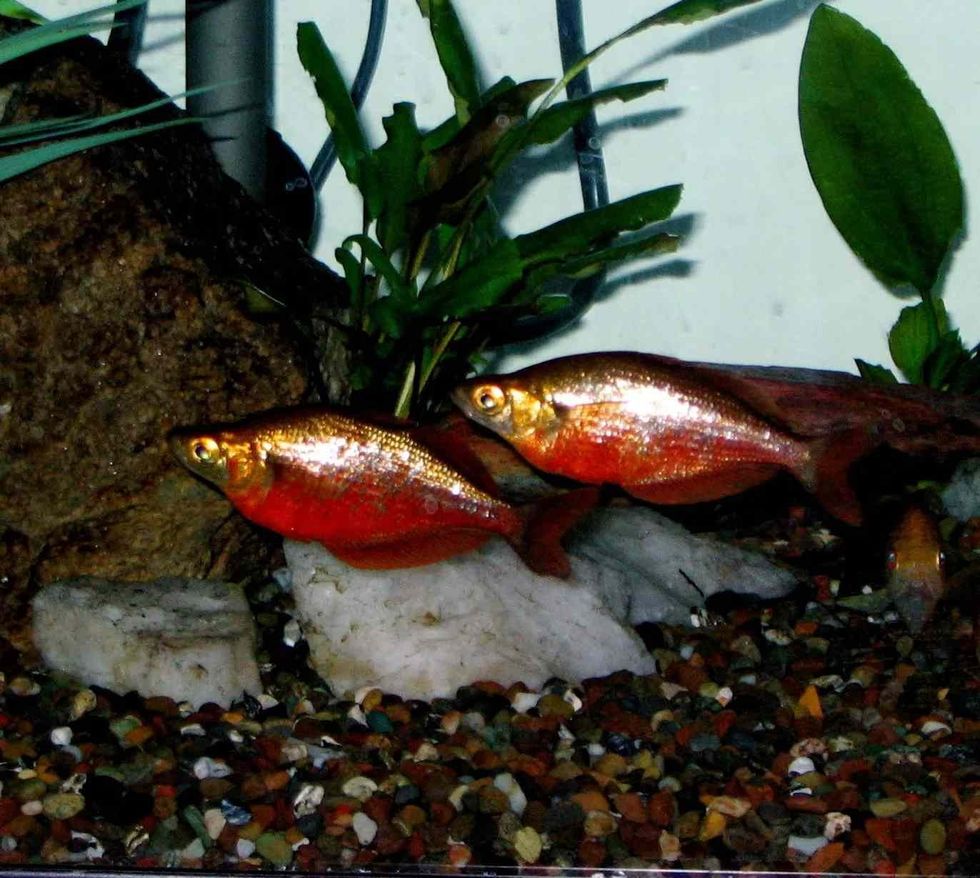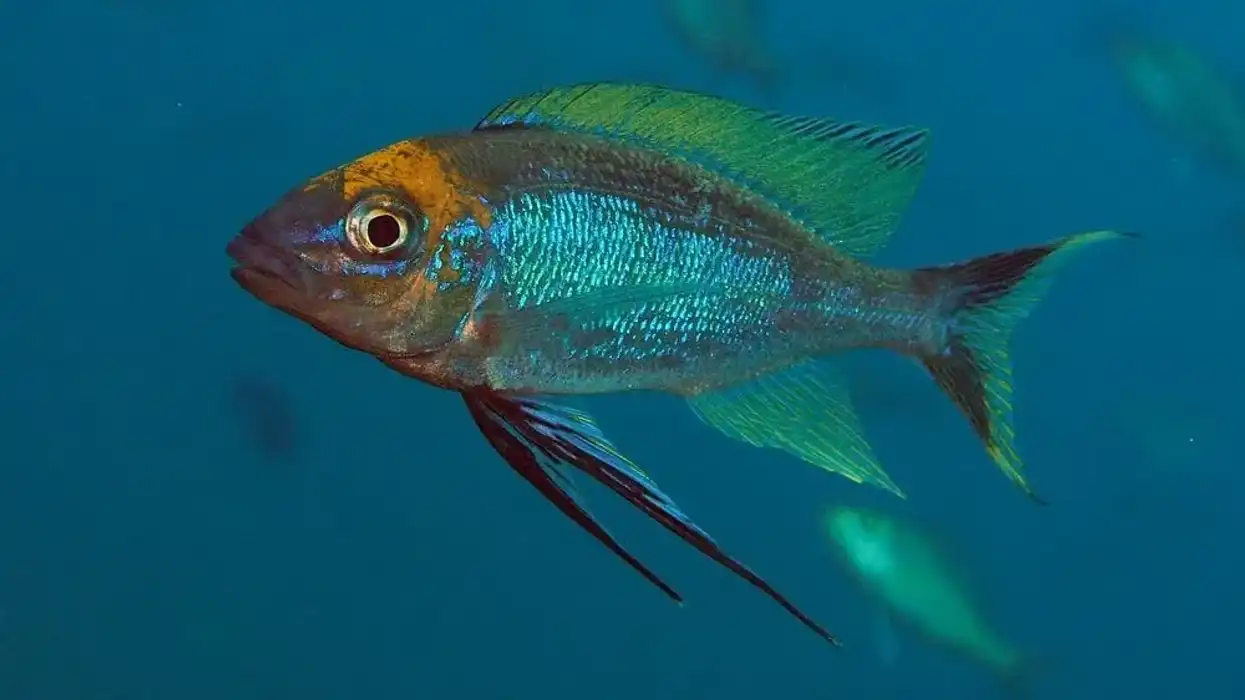The red rainbowfish (Glossolepis incisus) is a type of freshwater fish which is exclusively found in lake Sentani, in New Guinea. It is known for its vibrant, blood-red coloration which is apparent in adult males and is a much sought-after fish to make any aquarium brighter.
This fish is accustomed to a tropical habitat and is found at an elevation of 245 ft (74.7 m) above sea level, surrounded by lush green hills.
They follow a mostly carnivorous diet, however, they do occasionally snack on aquatic plants and green algae, making them omnivorous in nature.
To find out more about this stunning eye-catching fish, read on! For more relatable content, check out these rainbow cichlid facts and rainbow shiner facts for kids.
Red Rainbowfish Interesting Facts
What type of animal is a red rainbowfish?
The red rainbowfish, Glossolepis incisus, is a type of freshwater fish which is endemic to Lake Sentani in New Guinea.
What class of animal does a red rainbowfish belong to?
Red rainbow fish belong to the Actinopterygii class and are a type of fish.
How many red rainbowfish are there in the world?
In their natural habitat, the red rainbowfish is an endangered species. The exact number of these fish in the wild is unknown. However, they are a popular species with breeders and can easily be bred to keep as pets in aquariums.
Where does a red rainbowfish live?
The red rainbowfish can only be found in Lake Sentani, Irian Jaya, New Guinea, and its corresponding tributaries.
What is a red rainbowfish's habitat?
The red rainbowfish, being a freshwater fish, naturally resides in a tropical, densely planted habitat. In captivity, they prefer an alkaline environment in a pH range of 7.2-8.
They should be kept at a temperature of 75-82 °F (23.9-27.8 °C ), as they require warmer water in order to thrive. They adapt well to small water changes, and fish must be acclimatized to the water before being let into the aquarium. The red rainbowfish habitat is ideally an environment with gentle water movement.
Who do red rainbowfish live with?
Red rainbowfish are schooling fish and can often be found in schools of around 10 or more, which have a mix of both males and females.
How long does a red rainbowfish live?
Red rainbow fish live for about six to eight years in their natural habitat, or if cared for properly as pets.
How do they reproduce?
Red rainbow fish require some amount of vegetation to lay their eggs on and subsequently fertilize them. It is suggested that these fish be put into a separate, well-lit tank populated with java moss or spawning mops for breeding purposes. This is in order to reduce the risk of the eggs being eaten by other species in the aquarium.
When the female is ready to lay her eggs, the male will make a bright, colorful display and guide her to an ideal spawning location among the vegetation, where it will spawn upon the eggs once they are released.
The laying of eggs can take place over a long period of time and must be put to an end once the number of eggs the female lays starts to decrease. These eggs must then be left alone for a period of six to nine days, after which they will hatch.
The fry must initially be taken care of and be fed a liquid diet until they are ready to be moved into the regular tank.
What is their conservation status?
They are currently flagged as an Endangered fish species in the wild. This is mostly due to changes in the composition of the lake water of their natural habitat due to an increase in human activities.
However, they are very easy to breed in captivity and can conveniently be kept as pets, so there is currently not much danger to their population.
Red Rainbowfish Fun Facts
What do red rainbow fish look like?
The red rainbowfish is one of the most eye-catching fish around, with its bright red scales and high arched back. They shimmer beautifully as they dart around the tank, catching the rays of the sun on their diamante scales.
These fish share a number of characteristics with other rainbow fish, having two dorsal fins, a forked mouth, and round eyes.
The adult male is the most vibrant of all, with its blood-red shade depending on its surroundings, health age, and mood. The female fish and the fry, despite being called 'red', have a coloration of silvery olive green or brown and have clear gray fins.

*Please note that this is an image of a banded rainbowfish, a similar species to red rainbowfish. If you have an image of a red rainbowfish, please let us know at hello@kidadl.com.
How cute are they?
With their bright, shiny scales and rich red and green coloration, this fish is definitely a sight to behold. They are a very attractive fish, and valuable addition to any aquarium.
How do they communicate?
Since fish cannot communicate verbally, they connect by non-verbal cues. During mating season, the males will put on a colorful performance and display the mating stripe on their forehead to the females, who will take it as a sign that they are ready to mate.
Males may also show some signs of aggression to communicate that they want to mate, which females will pick up on.
The strongest male in the pack will usually shine the brightest red, to display its rank to the other fish. Keeping many males in a school will help to bring out brighter colors in them, as they compete to win the attention of females.
How big is a red rainbowfish?
They range in length from around 4.7-6 in (12-15 cm), which is 7.5 times the diameter of an average penny. They are smaller than tang fish.
How fast can a red rainbowfish swim?
They are active swimmers and hence require a larger tank size so that they can dart around without feeling constricted.
How much does a red rainbowfish weigh?
The exact weight of this species is unknown.
What are the male and female names of the species?
We can refer to both males and females of this species by the same name. However, we can differentiate between the two by looking at their color scheme. The red rainbow fish technically refers more to males as they are a bright, luminescent red compared to females who are typically a silvery, olive green in color.
What would you call a baby red rainbowfish?
Baby rainbowfish are called fry.
What do they eat?
The red rainbowfish diet is one of the most carnivorous around, with a largely meat-based diet in the wild. Despite living in a habitat with dense vegetation, it prefers to feed on insects, worms, and shrimp.
When kept in an aquarium it can be fed normal fish foods and live foods, however, it must be fed a protein-rich meat-based diet as well. It can be given small, frozen insects and seafood, as well as aquatic plant matter.
Are they aggressive?
These fish are generally peaceful and well-tempered when kept in schools. When kept in aquariums with similar-sized fish, they get along quite well with other species. However, keeping them with bigger fish may lead to them being picked on and turn them aggressive, and smaller fish may turn them into bullies.
During the breeding season, males become aggressive towards others males in the school and sometimes towards the females as well, which may prove to be dangerous for them if left alone together, so they should be kept an eye on.
Would they make a good pet?
Red rainbowfish is a naturally eye-catching and stunning addition to any tank. When kept with fish of similar size and requirements, they co-exist peacefully while adding a splash of coloration to the shoal.
They are generally easy to maintain when kept in good water conditions and can withstand slight changes to their environment, hence make a good pet for new fish owners.
Being active swimmers, they require a minimum tank size of 50-60 gal (227.3-272.8 L), with the ideal size being around 150 gal (682 L) to accommodate a number of coexisting fish.
Did you know...
They are also called salmon-red rainbowfish.
They are an endemic species and can only be found in Irian Jaya, in New Guinea.
They require an aquarium with good water conditions and dense vegetation which is ideal for them to hide as they are shy fish, and to lay their eggs on during breeding periods.
Being schooling fish, there are usually a large number of male and female fish together in one tank. This actually helps to bring out brighter red coloration in males, as they change color to catch the attention of the female fish.
They are pretty adaptable and do well with small water changes, making them easy to care for.
Naming the red rainbowfish
The red rainbowfish, Glossolepis incisus is named after the striking red color of the male fish. The color of this fish changes according to its moods, becoming brighter when it is satisfied with its surroundings.
Red rainbowfish tank mates
They do well with other similarly sized fish and enjoy plenty of live plants. Other species of rainbowfish, barbs, and tetras make good tank mates.
Since they mostly occupy the top of the tank, friendly bottom feeders such as loaches and catfish are also good fits for these fish. If the minimum tank size and water conditions are adhered to, plenty of live fish can be housed together.
Here at Kidadl, we have carefully created lots of interesting family-friendly animal facts for everyone to discover! For more relatable content, check out these mutton snapper facts and strawberry grouper facts pages.
You can even occupy yourself at home by coloring in one of our free printable Red rainbowfish coloring pages.









